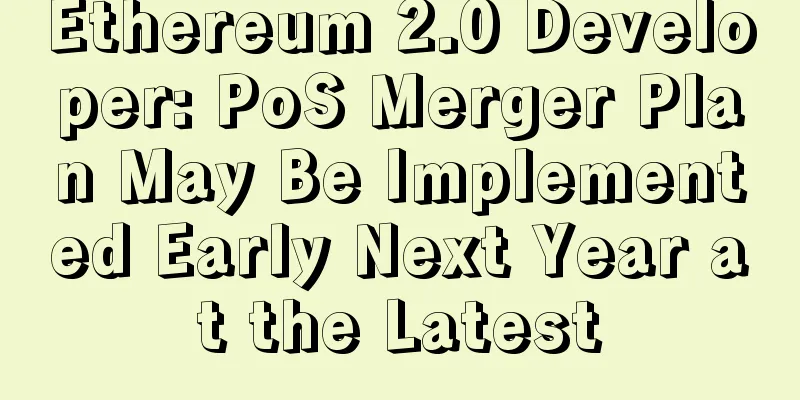Ethereum 2.0 Developer: PoS Merger Plan May Be Implemented Early Next Year at the Latest

|
Note: The original author is ConsenSys researcher and Ethereum 2.0 developer Ben Edgington. He expects the merger phase of Ethereum 1.0 and 2.0 to be completed at the end of 2021 or early 2022, which means that the Ethereum system will switch from the proof-of-work (PoW) consensus mechanism to proof-of-stake (PoS). Beacon ChainThere are currently over 132,000 active validators, with 4.2 million ETH staked (worth nearly $16 billion as of now), and the rate of new deposits has increased recently. Since the minor shock two weeks ago, everything has been going smoothly. Here is a detailed review of the incident from Prysmatic Labs. Unfortunately, after two full months of operation without any slashing, three isolated incidents occurred in the last month, and I have no information as to what caused them. StakingOne thing I really enjoyed was watching Adrian Sutton sync Teku from scratch in about a minute. The demo downloaded the initial state directly from Infura, although you can use any known synced beacon node or a downloaded file containing the state. This is a game changer for staking services and individual stakers. When syncing a beacon node is so fast (seconds instead of hours), you can basically forget about maintaining persistent storage and redundant setups. If you want to check how well your validator performs its validation duties, then take a look at Paul Hauner's spreadsheet tool and instructions. He provides more insights than the single "valid" number provided by Beaconcha.in. Are you aware of Secret Shared Validators? If not, now is a good time to catch up. Alon Muroch has written about the recent SSV Phase 1 testing round. RayonismRayonism, also known as a Russian abstract art style, is an ongoing effort that is being conducted in parallel with the Eth1/Eth2 merged testnet and sharding R&D. It emerged at the EthGlobal Ethereum Scaling Hackathon, but is sure to expand beyond that. Lukasz Rozmej from the Nethermind team put together a very nice video tutorial showing how to set up a merged testnet using Nethermind for the Eth1/execution side and Teku for the Eth2/consensus side. The big news is that the first developer testnet, Steklo, was live for just a few hours on Friday, April 30th. Steklo means "glass" in Russian, which means it will be vulnerable, and it proved to be so. To be fair, all teams infiltrated the network without any test vectors prepared, so this was the first blind attempt. Decrypt wrote an article about Steklo, and there were twelve client combinations in total: Nethermind, Besu, and Geth/Catalyst were paired with Teku, Nimbus, Lighthouse, and Prysm respectively. Lukasz provided a summary on the Rayonism Discord channel:
In short, a lot happened, and a lot of things went well, and overall the whole exercise was very encouraging. After some repairs, Lighthouse later reached consensus with Teku and Nimbus. Some common test vectors have been prepared over the last week so that clients can debug individually before coming together again. The plan is to have a longer-lived merged developer network in place early next week. AltairAltair is a relatively minor beacon chain update scheduled for release mid-year. According to recent developer calls, the various client teams are making fairly good progress implementing the Altair spec. We took this opportunity to sketch out a (non-committal) timeline:
There are still some things that need to be worked out before freezing the spec. In particular, how to handle this issue (losing an epoch of rewards during the upgrade). mergeCurrently, most of the merger activity is focused on Rayonism. Still, there is a lot of work to be done after Rayonism. Mikhail Kalinin summarized the public conversation in a thread on Rayonism’s Discord channel: First, the transition process (aka docking). We need to figure it out, write code and try it out in test/dev networks. Second, the sync algorithm; design work is already underway, then implementation and testing. Block proposal optimization techniques, communication channel protocol, whether JSON-RPC or REST; JSON-RPC modifications for users (adding a finalization block method). Writing specific EIPs that describe execution layer modifications. Fixing BLOCKHASH randomness issues. Multiple rounds of various tests. Chain tools, find evidence that they are useful. Infrastructure updates, the main question is what the block explorer will look like. We have a lot of things to do, but the highly optimistic view is that the merger will be completed by the end of the year, the more cautious view is in the first quarter of 2022, but no one expects it to be later than that. toolMy former colleague Mostafa Farghaly posted Kotal: Kotal is a blockchain deployer that makes it super easy to deploy highly available, self-managed, self-healing blockchain infrastructure (network, nodes, storage clusters, ...) on any cloud. It includes support for Teku, Nimbus, Lighthouse, and Prysm nodes, as well as IPFS and other Web 3 support. Original article: https://hackmd.io/@benjaminion/eth2_news/https%3A%2F%2Fhackmd.io%2F%40benjaminion%2Fwnie2_210508 By Ben Edgington |
<<: Nebraska could let state banks offer cryptocurrency services
>>: Block.one to launch crypto exchange Bullish this year, with Richard Li as senior advisor
Recommend
What palmistry is good for marriage?
Every woman hopes to marry well, so how can we te...
What are smile lines? Analysis of the facial features of women with smile lines
Such good luck as great fortune is really rare. T...
Economists warn that a major recession is coming to the U.S. How can ordinary people protect their wallets?
A recent CNBC survey showed that 81% of Americans...
Is Bitcoin trading considered money laundering in India? Indian minister says Bitcoin is illegal
In a written response to a question in the Rajya ...
Too many bad peach blossoms are the most likely to have an affair.
Speaking of extramarital affairs, I believe many ...
What kind of face does a woman have a good fate? What kind of face does a woman have a good fate?
To determine whether a woman has a good fate, we ...
How does your face look like? Is she pregnant?
You can also tell whether you are pregnant from y...
Institutional investors prefer Bitcoin, is this the beginning of a digital currency investment boom?
Mike Cannon-Brookes has revealed his Bitcoin inve...
The connection between a person's appearance and destiny
What is the connection between a person’s appeara...
The facial features of a woman who brings good fortune to her husband: a high nose
In physiognomy, one can tell a person's fortu...
Why Tesla's reversal is good for Bitcoin
Earlier this week, Tesla announced that it would ...
12,000 BTC flowed out of Coinbase, possibly hoarded by institutions
According to CryptoQuant CEO Ki Young Ju, 12,000 ...
Analysis: What does the six palaces of physiognomy mean?
Physiognomy is one of the traditional physiognomy...
Facial features of people who are prone to making mistakes at work
Making mistakes at work is a serious matter. It m...
Analysis of personality and destiny of people with moles on upper eyelids
Traditional physiognomy covers a wide range, among...






![[Evaluation] Biyin's "Hashrate Hedging" Retest Theoretical and Actual Benefit Comparison](/upload/images/67e6c224cdbf6.webp)


